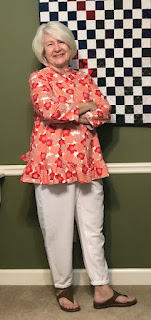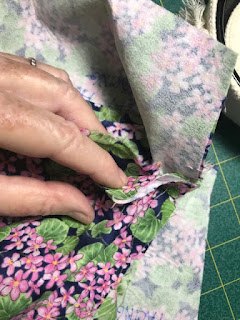But I was not totally surprised when she announced this past weekend that they are having a super small wedding rather than waiting for the virus to go away. I am sad that I cannot be there, really sad. But this gave me an excuse to pull out my maternal grandmother's wedding dress and send it to Chelsea, in case she can incorporate it in some way.
After I had been married a number of years, my mother mentioned to me that she had her mother's wedding dress. I was very surprised because I had made my own wedding dress. I wondered if I would have used it in any way, had I known she had it.
1970
My mother married toward the end of World War II and so had a very small wedding. I don't think she ever thought about keeping something from her wedding. She wore a pink wool suit. I expect, given the war times, she probably needed to wear it, and she wore it out.
1945
I never knew my maternal grandmother. She was pregnant with my mother during the great influenza outbreak and died from flu-related pneumonia a few days after Mother was born, December 31, 1918.
My maternal grandmother (light hair) with her older sister.
As we experience another world-wide pandemic, I continue to wonder about my grandmother. I've never really sorted out the design of her dress. There are no wedding pictures, and my own mother had no knowledge of her parents' wedding.
Grandmother with my uncle Ed, who was a few years older than my mother.
It is made of either cotton or silk organza, edged in lace. It is all very sheer, so I imagine she wore a full slip, and even white stockings underneath it all. I believe it is what is called tea length.
I think the waistline is slightly raised. The bodice has a V neck and snaps up the front. It has a blouson effect at the waistline. The back of the bodice is solid and extremely sheer with a double layer across the shoulder blades. The back neckline also has a little pleated lacy flounce attached. The set-in sleeves appear to be 3/4 length with a lace edging on the organza.
The skirt was gathered onto Petersham that is about 1.25 inch wide. The Petersham is turned down. The skirt has an opening at the back that is about 6 inches long. Like the front, it closes with snaps.
There are two layers to the skirt. The upper skirt is wider and has a lace border that is most intense near its hem. The under skirt is about 6-8 inches longer than the upper skirt. The lining is more narrow and has pin tucks near the hem. The hem is finished with a row of lace like that on the sleeve hems.
Then there is a sheer sleeveless bolero or vest that I assume slips over the bodice with the back neckline flounce pulled to the right side. It has V neckline that is deeper than the bodice and closes in the front with a large covered button and snap.
The skirt was only half attached to the bodice so, in order to get a better understanding of it, I basted the rest together.
It looks like the Petersham, and the skirt, and the bodice are only basted together. The entire garment appears to be stitched by hand, so it's hard to be sure if it was basting or permanent.
This brings me to the mysterious part. You may have noticed that the bodice opens in the front and the skirt opens in the back. So, unless she was sewn into it, I cannot figure how she put it on.
Probably about 1916 with my grandfather and uncle Ed.
She married June 21, 1915 in Ellis County, Texas (USA), probably in or near Maypearl. I have a few pictures of her, as you can see. After writing most of this post, I uncovered an additional picture of my grandmother. As I look closely, I'm quite certain that she is wearing the dress we thought to be her wedding dress. She is pictured again with my uncle, so some years after her wedding.
All these decades, we have thought this was her wedding dress. Now I'm pretty sure we were wrong. I'm still glad we kept it. It is a sweet example of sewing from more than 100 years ago.
From the front with the bolero/vest over the bodice
Maybe she wearing her wedding dress here. It does look like a wedding portrait.










































